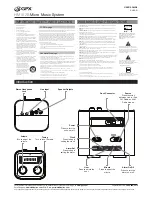
21
The fifth page of the MIDI menu shows the “store enable“ flag represented by a capital „S“ in the display. The
value “0” disables the reception of controller #18, and therefore protects the user presets from being modified
via MIDI. Accordingly, the value “1” enables MIDI controller #18 so that you can modify or replace presets
with a remote MIDI device or a sequencer. In this case the actual settings will be stored directly to the location
that corresponds to the controller value.
+
Attention! Since the “store enable“ mode allows you to access memory locations directly via
MIDI, it is possible that stored presets will be replaced or altered if controller #18 messages are
sent on the same MIDI channel. The purpose of this mode is to facilitate MIDI backup and
restore operations without express confirmation at the FEEDBACK DESTROYER. It is therefore
recommended to disable (flag=0) this mode as soon as the intended data transfer has ended.
This is done automatically when you switch off the FEEDBACK DESTROYER.
On the sixth page you will find the
Bulk Dump menu, which is indicated by a “0d” in the display. This function
enables you to backup all presets to an external sequencer and to write them back again. By turning the jog
wheel the display changes to “1d” or “2d”. In mode “1d” you can switch the FEEDBACK DESTROYER to
receive mode. Mode “2d” allows for sending the complete memory content to an external MIDI device. To
confirm your choice simply press the flashing STORE key. Floating dots in the display indicate a readiness
and a flickering IN/OUT key signals MIDI activity. To leave the receive mode and to abrupt the sysex receiving
simply press any other key.
+
During a bulk dump all audio functions of the FEEDBACK DESTROYER will be deactivated.
To leave the MIDI menu you have to press a key which does not belong to the MIDI key combination (the
MIDI mode is canceled automatically when you have not made any entry on one of the six pages for a certain
time - exception: modes “1d” and “2d”).
The full-featured MIDI implementation of the FEEDBACK DESTROYER allows for easily integrating the
FEEDBACK DESTROYER into any MIDI system.
s
MIDI IN
Any MIDI data sent to the FEEDBACK DESTROYER (sequencer, MIDI footswitch, etc.) are received via the
MIDI IN jack. For example, if you wish to use the FEEDBACK DESTROYER as an effects device for your
guitar rack, you can connect the MIDI IN jack to a MIDI footswitch that allows for selecting program presets.
If your rack includes another MIDI effects device (e.g. a multi-effects processor), the data sent from the MIDI
footswitch can be routed via the FEEDBACK DESTROYERs MIDI THRU jack to your multi-effects proces-
sor.
s
MIDI THRU
The MIDI THRU jack is used to loop through incoming MIDI data, i.e. any control data received at the MIDI IN
of the FEEDBACK DESTROYER will be transmitted via the MIDI THRU jack to other MIDI devices/instru-
ments.
s
MIDI OUT
The MIDI OUT jack allows for transmitting MIDI data that originate from the FEEDBACK DESTROYER. We
are currently developing a software editor which will allow for storing single items of the FEEDBACK
DESTROYER`s internal data on an external medium. Thus, it will be possible to archive FEEDBACK
DESTROYER settings and presets on a computer, sequencer or MIDI data recorder. Both MIDI Control
Change and MIDI Program Change commands will be transmitted when you edit or recall filter settings.
Detailed information on this future software editor are available from our Behringer hotline (Germany: tel.
(0)2154-920666), our international distributors and/or our Internet homepage http://www.behringer.de.
5.6 The basics of digital signal processing
To convert continuous analog signals into a series of digital words, a so-called “Analog to Digital Converter”
(ADC) is used. The converter functions by viewing the signal entering it a given number of times over a period
of time, e.g. 44100 times per second, giving a rate of 44.1 kHz, and in each case measuring the signal
amplitude, and giving it a numerical value. This form of measuring the signal regularly over a period of time is
known as “sampling”, the conversion ot the amplitude into a numerical value, quantizing. The two actions
together are referred to as digitizing.
In order to carry out the opposite - the conversion of a digitized signal into its original analog form - a “Digital
to Analog Converter” (DAC) is used. In both cases the frequency at which the device operates is called the
5. OPERATION












































